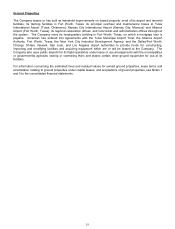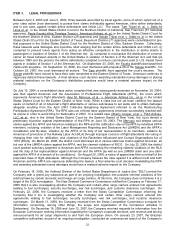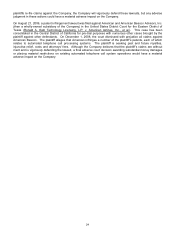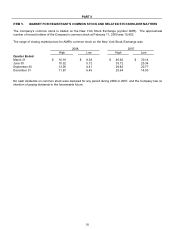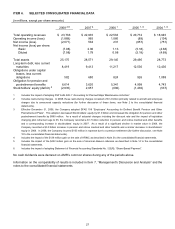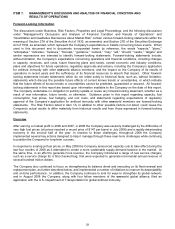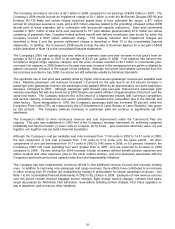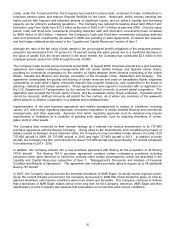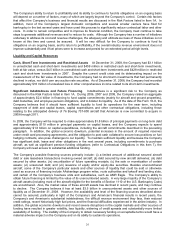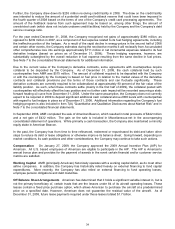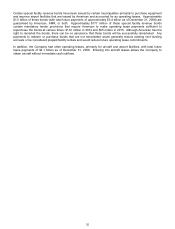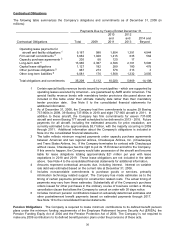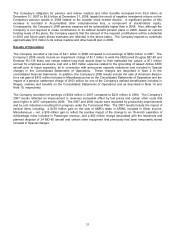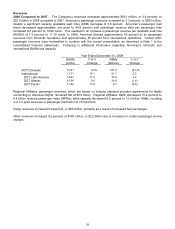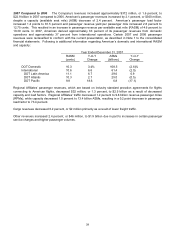American Airlines 2008 Annual Report Download - page 33
Download and view the complete annual report
Please find page 33 of the 2008 American Airlines annual report below. You can navigate through the pages in the report by either clicking on the pages listed below, or by using the keyword search tool below to find specific information within the annual report.30
Lastly, under the Turnaround Plan, the Company has worked to reduce debt, continued to make contributions to
employee pension plans and improve financial flexibility for the future. Historically, airline industry earnings are
highly cyclical with frequent and extended periods of significant losses, and an airline’s liquidity and borrowing
capacity can be critical to sustaining operations. The Company has reduced its balance sheet debt (Short-Term
Debt plus Long-Term Debt) from $13.2 billion at the end of 2002 to $11.0 billion at year end 2008. Over the same
period, Cash and Short-term investments (including restricted cash and short-term investments) have increased
by $900 million to $3.6 billion. However, the Company’s Cash and Short-term investments (including restricted
cash and short-term investments) decreased in 2008 due primarily to debt repayments, increased fuel expense
and fuel hedge collateral as discussed in the “Liquidity and Capital Resources” section of Item 7.
Although the ratio of the fair value of plan assets to the accumulated benefit obligations of the employee pension
programs has decreased from 75 percent to 70 percent during this same period due to a significant decrease in
the value of assets from the recent decline in the stock market, the Company has contributed $2.1 billion to the
employee pension plans from 2002 through the end of 2008.
The Company made several announcements during 2008. In August 2008, American entered into a joint business
agreement and related marketing arrangements with UK carrier, British Airways, and Spanish carrier, Iberia,
providing for commercial cooperation by the carriers on flights between North America (consisting of the United
States, Canada and Mexico) and Europe (consisting of the European Union, Switzerland and Norway). The
agreement contemplates the pooling and sharing of certain revenues and costs on transatlantic flights, expanded
codesharing on each other’s flights, enhanced frequent flyer program reciprocity, and cooperation in the areas of
planning, marketing and certain operations. These agreements were signed in connection with an application to
the U.S. Department of Transportation by the carriers for antitrust immunity to permit global cooperation. The
application also included the Finnish carrier, Finnair, and the Jordanian carrier, Royal Jordanian. If granted (which
cannot be assured), antitrust immunity will permit the five carriers, all of whom are members of the oneworld
airline alliance, to deepen cooperation on a bilateral and multilateral basis.
Implementation of the joint business agreement and related arrangements is subject to conditions, including
various U.S. and foreign regulatory approvals, successful negotiation of certain detailed financial and commercial
arrangements, and other approvals. Agencies from which regulatory approvals must be obtained may impose
requirements or limitations as a condition of granting such approvals, such as requiring divestiture of routes,
gates, slots or other assets.
The Company also continued its fleet renewal strategy as it entered into various amendments to its 737-800
purchase agreement with the Boeing Company. Giving effect to the amendments and considering the impact of
delays caused by Boeing’s recent machinist strike, the Company is now committed to take delivery of a total of 29
737-800 aircraft in 2009, 39 737-800 aircraft in 2010 and eight 737-800 aircraft in 2011. In addition to these
aircraft, the Company has firm commitments for eleven 737-800 aircraft and seven Boeing 777 aircraft scheduled
to be delivered in 2013 - 2016.
In addition, the Company entered into a new purchase agreement with Boeing for the acquisition of 42 Boeing
787-9 aircraft. The Boeing 787-9 purchase agreement contains certain contingency provisions including
provisions which allow American to cancel the contract under certain circumstances, which are described in the
Liquidity and Capital Resources subsection of Item 7. “Management's Discussion and Analysis of Financial
Condition and Results of Operations”. The agreement also includes purchase rights to acquire up to 58 additional
Boeing 787 aircraft.
In 2007, the Company had announced the intended divestiture of AMR Eagle, its wholly-owned regional carrier.
Given the current industry environment, the Company announced in 2008 that it had decided to place on hold its
planned divestiture until industry conditions were more stable and favorable. The Company continues to believe
that a divestiture of AMR Eagle makes sense in the long term for the Company, American, AMR Eagle and their
stakeholders, but the Company also believes that a divestiture is not sensible amid current conditions.



